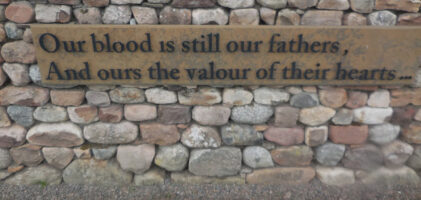
Today’s posts is all about the maybe most important battle in Scottish history.

The Battle of Culloden, which was fought on a field just outside of Culloden on the 16th of April 1746 and was the last battle during the Jacobite Rising of 1745. There where lots of small uprisings afterwards but none of them was significant for history since those were more little feuds between the Scottish peoples under Prince Charles Edward Stuart, who were upset by the Culloden following consequences and the English under the Duke of Cumberland.

The Battle of Culloden can also be counted as the last battle fought on British soil.
Background:
The Jacobite Risings were supposed to overthrow the House of Hanover and bring the House of Stuart back on not just the Scottish but also the Scottish throne. After victorious battles down south towards England and the following withdrawal back to Inverness the Jacobite’s didn’t have any other opportunity than to meet their opponents at Culloden Moor which was less than ideal for the Highlanders usual fighting techniques. Even the French supporters in the battle, few in numbers, couldn’t turn the unavoidable fate of the loyal Scots around.

The well-supplied Hanoverian Government army (the English) faced the forces of Charles Edward Stewart “The Young Pretender” as the final battle. It also needs to be mentioned, that there weren’t just English soldiers fighting on the English army but also some Scottish Clansmen, whole Clans fought for the English that day.
With a clear advantage it is no wonder how the battle ended, this bloody massacre which marked the end of Scotland as it has been before. Weapons, traditions, clans, bagpipes, Tartans and so much more was forbidden afterwards, a lot of Scottish Heritage lost.
The 6,000 men strong army did not stand a chance with all the typical Highland techniques being doomed to fail.

Added to this disadvantage Charles chose to stage a defensive action and confront the English at the Moor rather than launching a guerrilla campaign, as suggested by some of his supporters. He may have been the rightful heir to the Scottish throne, but he wasn’t much of a trained and experiences warlord and choose this battleground which just beard disadvantages for his cause and his men, dooming them to die. So rather than to storm downhill towards their enemies the Scottish army had to fight on marshy rough ground, which favoured the Government forces. The rain that morning made things even worse, and the Jacobite’s were battered by Cumberland’s artillery within the first half-hour of the battle.

After the roundshot’s and grapeshot’s of the English were mostly through Charles finally issued the order for his Highlander army to charge towards the enemy.
The Scots having been 2,000 men short in number compared to the number of Cumberland’s army (8,000 men) from the beginning on were now even fewer in number when the Highlanders finally reached the Government lines. The Redcoats new tactic of bayoneting the exposed side of the man to the right rather than the ones right in front of them worked its magic and forced the Highlanders to break up and flee.
The whole battle lasted less than an hour but had already cost so many lives.

Consequences:
During the following weeks, the Jacobite’s that fled the battlefield, were hunted down and killed, nearly none of them surviving. Prince Charles Edward Stuart managed to escape himself and escaped with the help of the famous Flora MacDonald, being dressed as her Maid, he first fled to Skye and from there to France and back into exile. He never came back to Scotland and didn’t launch any further attempts to get back the Scottish or British throne.
The British Governments army winning the battle not just Scots lost their lives but also some English soldiers. In numbers of the 8,000 British soldiers about 300 lost their live during the battle, from the 6,000 Jacobite’s 1,500 – 2,000 lost their lives just during the battle with the rest being either hunted down and killed or hunted down and deported to America as slaves.

When you think about that there is no wonder why so many Americans have family connections to Scotland, even if their ancestors weren’t deported many Scots fled due to the government’s new laws for the Highlands and Scottish people.
If you take a look at the wall, which is shown in the picture above you will see that there are quite a few stones which are moved a slight bit forward. Each of those stones represents one of the fallen English soldiers, the stones seemingly in the normal position represent the fallen Jacobites.
Pay a visit to the visitor Centre at the Battlefield (for addiotional charge, the Battlefield itself is completely free).
Across the Moor you can find stones as shown below, showing each person passing where the clanmembers got burried. They first were tossed all together on a big pile. The one thing you have to give the English is that they at least kinda sorted the fallen after the Clan they belonged to and so where there is now a Clan Fraser stone, behind it is a small hill which still shows where the ashes were burried.

Last for this post I want to ask something of you, when you visit Culloden Battlefield and all the other places in Scotland, you have to watch yourself. Honouring the graves is okay but you should watch where you put your feet.
Close by and also connecting Culloden Battlefield to Clava Cairns is the following route, which leads you from the Town of Culloden, to Culloden Battlefield and on to The Clava Cairns.

Pingback: Linlithgow Palace – A scottish World
Pingback: The Battle of Prestonpans – A scottish World
Pingback: Blair Castle, Blair Atholl – A scottish World
Pingback: Ruthven Barracks – A scottish World